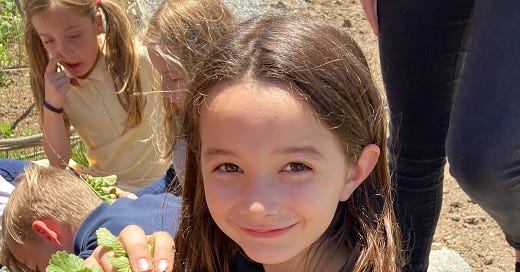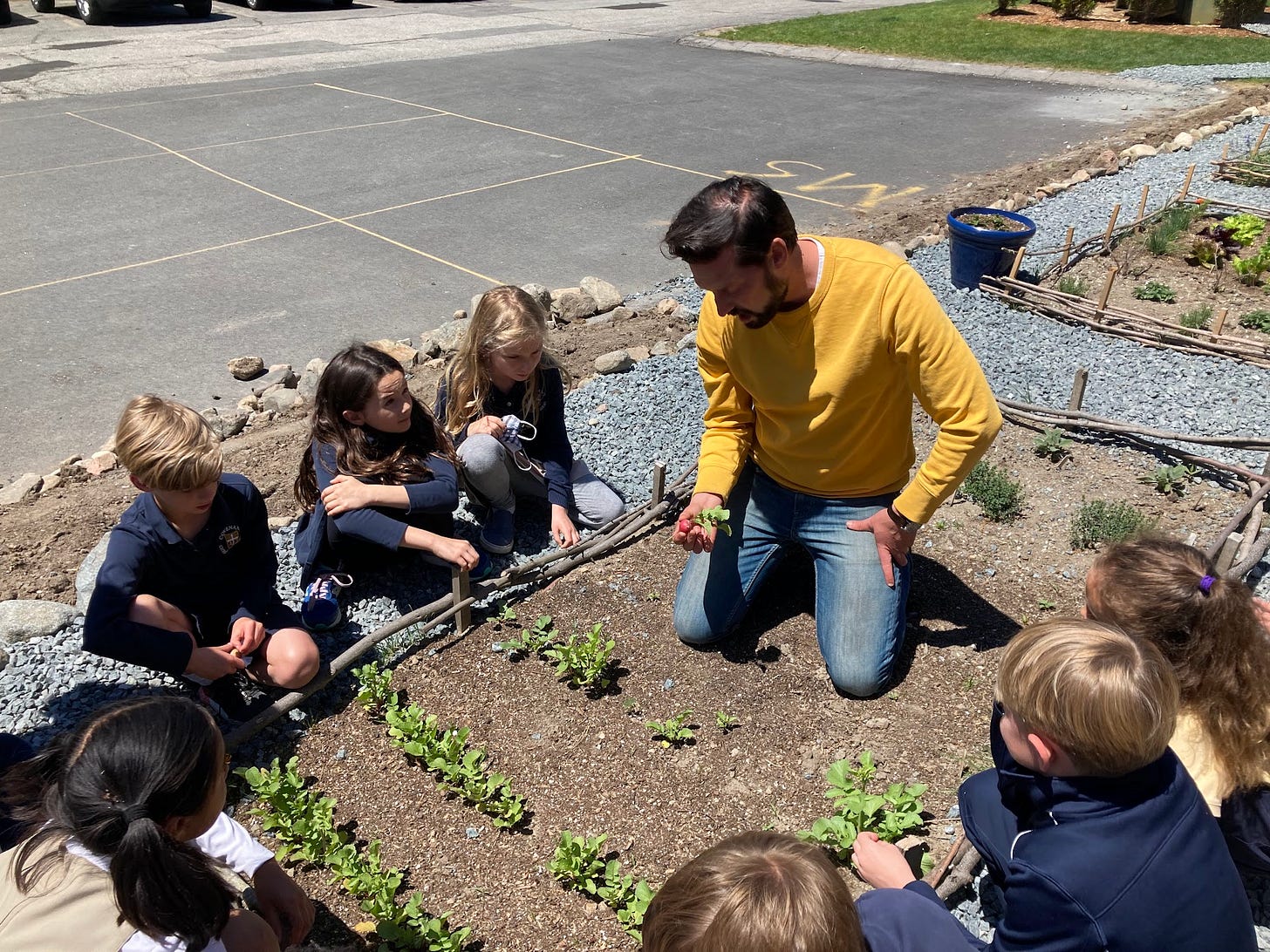Spreading the Word
Spreading the word is like spreading seed. And we need to cast it far and wide.
“Could we come out and harvest them ourselves?” asked a teacher from our Grammar School, as if she were causing me a huge inconvenience. “We’re doing a unit on plant life cycles, and pulling real radishes out of the ground would be much more powerful than just looking at videos or pictures.” Of course, this idea was far from an inconvenience: it was a milestone; something I’d been waiting for.
Radishes are one of the fastest-maturing crops we can grow in this part of the world: some will go from seed to harvest in as little as eighteen days. They are also among the tastiest, especially when they’re fresh. One bite of a radish taken straight from the garden will immediately put the store-bought, plastic-bag varieties to shame with its intense wasabi-like punch followed by a creamy mellowness. French schoolchildren famously dip fresh radishes in salted butter as a snack, an absurdly classy habit that likely contributed to France’s cultural domination of Europe in the eighteenth century.
Yet American schoolchildren haven’t inherited all those centuries of la bonne cuisine, and therefore usually express little interest in the humble radish. It was therefore with some trepidation that I welcomed an entire second-grade class into the Classical Roots Vegetable Garden one May morning to harvest them. The kiddos had visited briefly around three weeks before to plant the radishes in clean little rows, and their excitement was palpable as they gathered ‘round to begin the harvest. My doubt melted into enthusiasm and even gratefulness as they actually shoved each other aside for a chance to pull the plump handfuls of green and red out of the earth.
Even more surprising was what happened next. I’d brought a little basket along to gather the harvested radishes and bring them home, where I planned to pickle a few and eat the others in a salad. But the basket never got used, because not a single radish survived its encounter with the Second Grade. Every single one was eaten, on the spot. Some of the students didn’t like the flavor, but most wolfed them down while they were still warm from the earth, praising the taste and asking for more. I was left with a bemused face and a pile of stems, which we brought to the compost straight away.
The whole situation bore out a theory that I’d heard about but never seen in practice: that a child is significantly likelier to eat healthy veggies if they’ve participated in the growing of them. I happened to have some seeds on hand, and distributed pinches of them in hastily-gathered ziplock bags for students to take home. Who knows how many of these were actually planted, but it hardly matters: a cycle had palpably begun, a cycle that connected students to their families, to their school, and to healthier, tasier food.
Clearly, our garden is yielding a spiritual as well as a natural harvest. Faced with a program like Classical Roots, most parents and educators tend to ask the same set of questions: where does something like this fit into a K-12 College-Prep school? Is it curricular or extracurricular? What tangible benefits will it provide? All of these questions are healthy and appropriate. Yet the answers, if we consider the whole proposal deeply, might come in the form of an alternate set of questions.
Why would we take annual field trips to farms, marshes, and nature preserves as part of our core science classes if we could encounter the same biodiversity on our own grounds? What implicit message are we sending to our students about humanity’s relationship to creation if we outsource all of our encounters with nature? Or when our campus is a close-clipped series of fertilizer-laced lawns that constitutes a biological desert? Why is it that every time our art teacher teaches lessons on en plein air painting, she brings her class always and only to the vegetable garden or the orchard? Why am I constantly finding that students have moved the outdoor furniture that normally sits in our mowed “green spaces” into the vegetable garden? And why are my tenth and twelfth graders, even in the snowy dead of New England winter, constantly poking their heads into my classroom to ask “if there’s anything in the garden that needs doing?”
One thing I like to tell my literature students is that good books often leave us not with answers, but with better questions. I’m finding that the Classical Roots Program has had the same sort of positive, revisionary effect on me and this community. In my own mind, at least, it’s grown from a wacky and precarious idea into something that lies near the heart of our school’s identity.
Yet, although these gardens are perennial, they’re not immortal. The whole program cannot grow without the support of the people who read this newsletter. If you’re the generous sort of soul who closes your laptop or your smartphone browser after one of these entries asking what can I do to help? I have a simple and urgent answer for you: you can share this newsletter with abandon. Blast it to the hills, to your friends. To your green-thumbed acquaintances, to your educators, to your colleagues, to your spouses, to your irritating neighbors.
In the three years since Classical Roots began, I’ve learned that the chief enemy of its growth is not a lack of impact on the students, nor a shortage of in-person enthusiasm from the faculty or parents, but an absence of hard numerical evidence that the whole thing matters to people. School administrations are busy, harried groups of people who can often only afford to support ideas that are measurably and obviously demanded by the community. Our administration here has been shockingly supportive and constantly generous but, if there is to be a paradigm shift from considering Classical Roots as an extra thing to considering it “an essential part of who we are and what we do,” you, my dear readers, are going to be the ones that make it happen. It’s beyond my powers. Even if you have no direct connection to our school, driving up the subscriber numbers here at the Substack is actually the best gift you can give us. It really does matter, because it produces metrics, and metrics talk.
So please consider spreading the word. In my wildest daydreams, this program becomes a repeatable model that can be used to pioneer a new kind of school programming in the U.S., a national call to recover a lost but essential element in education—one that soothes the stress, renews the bodies, and strengthens the spirits of a generation whose future seems increasingly uncertain. But at the very least, I want to keep doing this work with our students here and now, and in the years to come. If that is going to happen, we’ll need more people to along for the ride. And that’s where you come in.








